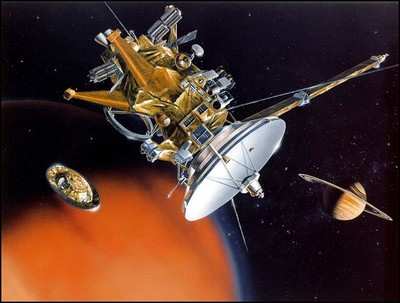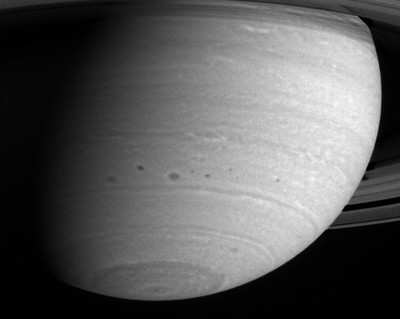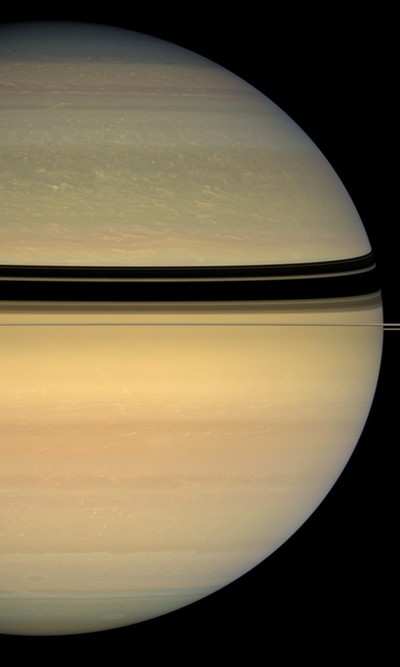Thu, Jun 04, 2009
The forecast for Titan's early autumn -- warm and wetter.
Cloud chasers studying Saturn's moon Titan say its clouds form
and move much like those on Earth, but in a much slower, more
lingering fashion.

Scientists with NASA's Cassini mission monitored Titan's atmosphere
for three-and-a-half years, between July 2004 and December 2007,
and observed more than 200 clouds. They found that the way these
clouds are distributed around Titan matches scientists' global
circulation models. The only exception is timing -- clouds are
still noticeable in the southern hemisphere while fall is
approaching.
"Titan's clouds don't move with the seasons exactly as we
expected," said Sebastien Rodriguez of the University of Paris
Diderot, in collaboration with Cassini visual and infrared mapping
spectrometer team members at the University of Nantes, France. "We
see lots of clouds during the summer in the southern hemisphere,
and this summer weather seems to last into the early fall. It looks
like Indian summer on Earth, even if the mechanisms are radically
different on Titan from those on Earth. Titan may then experience a
warmer and wetter early autumn than forecasted by the models."

On Earth, abnormally warm, dry weather periods in late autumn
occur when low-pressure systems are blocked in the winter
hemisphere. By contrast, scientists think the sluggishness of
temperature changes at the surface and low atmosphere on Titan may
be responsible for its unexpected warm and wet, hence cloudy, late
summer.
Seasons on Titan last more than seven Earth years. As Titans'
summer changes to fall at the equinox in August of this year,
Titan's clouds are expected to disappear altogether. But,
circulation models of Titan's weather and climate predict that
clouds at the southern latitudes don't wait for the equinox and
should have already faded out since 2005. However, Cassini was
still able to see clouds at these places late in 2007, and some of
them are particularly active at mid-latitudes and the equator.

Titan is the only moon in our solar system with a substantial
atmosphere, and its climate shares Earth-like characteristics.
Titan's dense, nitrogen-methane atmosphere responds much more
slowly than Earth's atmosphere, as it receives about 100 times less
sunlight because it is 10 times farther from the sun.
More News
Pilot Also Reported That Due To A Fuel Leak, The Auxiliary Fuel Tanks Were Not Used On June 4, 2025, at 13:41 eastern daylight time, a Piper PA-23, N2109P, was substantially damage>[...]
From 2023 (YouTube Edition): Reflections on War’s Collective Lessons and Cyclical Nature The exigencies of war ought be colorblind. Inane social-constructs the likes of racis>[...]
Pilot Reported That He Was Unfamiliar With The Single Seat Amateur-Built Airplane And His Intent Was To Perform High-Speed Taxi Testing Analysis: The pilot reported that he was unf>[...]
From 2023 (YouTube Edition): First Kits to Ship October 2023 Having formerly resurrected the storied shape of the Ryan ST—in effigy, anyway—Montrose, Colorado-based Tim>[...]
Performance-Based Navigation (PBN) [ICAO] Area navigation based on performance requirements for aircraft operating along an ATS route, on an instrument approach procedure or in a d>[...]
 NTSB Prelim: Piper PA-23
NTSB Prelim: Piper PA-23 Classic Aero-TV: One Mans Vietnam
Classic Aero-TV: One Mans Vietnam NTSB Final Report: Capella Aircraft Corp FW1C50
NTSB Final Report: Capella Aircraft Corp FW1C50 Classic Aero-TV: Timber Tiger Touts Curtiss Jenny Replicas
Classic Aero-TV: Timber Tiger Touts Curtiss Jenny Replicas ANN's Daily Aero-Term (07.04.25): Performance-Based Navigation (PBN) [ICAO]
ANN's Daily Aero-Term (07.04.25): Performance-Based Navigation (PBN) [ICAO]





